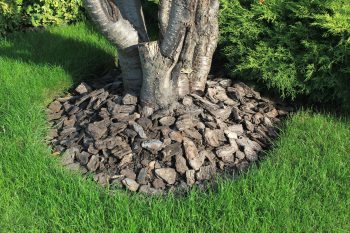 When it comes to landscaping, exposed tree roots can get in the way. This normally occurs due to the root system growing in poor conditions.
When it comes to landscaping, exposed tree roots can get in the way. This normally occurs due to the root system growing in poor conditions.
The two most common causes are clay-rich soil, or a hard foundation beneath the topsoil. Either circumstance prevents the tree roots from digging more deeply into the ground. They respond by changing the direction of growth, which can result in some roots breaking through the ground surface.
While some people think that exposed tree roots are a charming feature, they can certainly making it much trickier to mow and landscape.
Visit our Fort Worth Landscaping service page to find out more about how we can help you keep your yard healthy and manicured.
Here are four methods you can try, to resolve the situation of exposed tree roots:
Groundcovers
Groundcover plants are low-lying “creepers” that tend to grow outward rather than upward. When planted between exposed roots, they eventually spread enough to sufficiently hide the roots, at least partially.
Groundcover plants cause no damage to the tree, and they eliminate the need to cut the grass around the tree. A botched attempt to mow or edge around the root system can damage the roots. Thus, planting groundcovers that require minimal maintenance is a safer way to keep that area of your yard looking attractive and well-maintained. .
You want to make sure you water the ground beneath the tree, especially where the roots are. Trees absorb a lot of the water, and you want to provide enough for both the tree and the groundcover to thrive.
Choosing the right groundcover plant is key, as you want it to thrive in the shade under the tree. Learn more about groundcovers that are shade hardy.
North Texas soil is notoriously clay-heavy, but that doesn’t necessarily mean your trees are at risk of health issues. Learn more about Planting Trees in Clay Soil.
Walkways
When tree roots grow, they can disrupt walkway paths and pavers. To solve this, a good change is to use stepping stone pavers in between the roots. You want to make sure that the pavers are the same height as the roots so that you don’t trip.
Another option is to install boardwalks over the roots. That way, when you use the boards, you are walking over the roots instead of risking an injury.
When making the framework for the walkways, make sure not to damage any of the roots as you place the ground structure. Focus on the areas between and around the exposed root system.
Mulching
Another method to conceal tree roots is mulching. Keeping the ground grass-free allows optimal access for the roots to absorb water and nutrients in the soil.
Make sure to use inorganic mulch that is suited for mulching over roots. Organic mulch will eventually break down, which could harm the exposed roots.
Rock and stone mulches are a great choice. Be sure you allow space for both air and water to reach the topsoil. Doing so will prevent the risk of root rot.
Soil Covering
The last option that isn’t the best, is to have a bed of soil over the roots. However, you have to do it correctly to maintain a healthy root system. This includes keeping the ground saturated with nutrients for the tree roots.
Topsoil should be placed in multiple stages. You want to add only half an inch to an inch every two to three weeks, allowing time for the roots to adjust to the change.
You also want to make sure you use the right soil. Never add clay soil, as it can restrict air flow and water flow. Not to mention it can also lead to fungal issues with the roots.
The best option for soil covering is a mixture of loam and coarse sand. This combination allows water drainage and better airflow for the roots.
